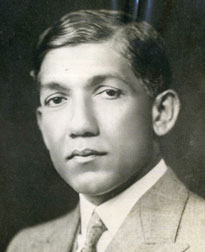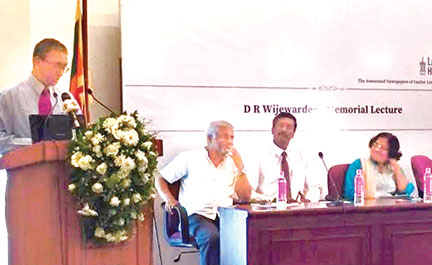Can good journalism outlive newspapers?
by Nalaka Gunawardene
 |
|
Media mogul D.R.
Wijewardene |
Adapted from the writer’s remarks made at the D. R. Wijewardene
commemorative event held on 26 February 2016 at the Lakshman Kadirgamar
Institute, Colombo
Can newspapers survive the challenge from digital and online media?
Plenty of printer’s ink has been spent reflecting on this question.
There are no easy answers, and perhaps we also need to rephrase the
question.
I begin by declaring a bias: I am rather partial to paper and ink. I
grew up reading newspapers from the age of five, and for several years
in my early career, I made a modest living working for an English
language newspaper.
Many like me, of a certain age and above, seem to have a nostalgic
attachment to newspapers. One key question for the print industry:
Beyond tapping such sentimental appeal (which diminishes over time), can
newspapers stay relevant and viable? How can they adapt and evolve to
keep serving the public interest?
History is not always a reliable guide, but in this instance, it may
well be.
 |
|
The author and the
panellists at the D.R. Wijewardene Commemorative event |
The modern mass media in Sri Lanka has a history of just under two
centuries. If we don’t count the government gazette, which was started
by the British rulers in 1802, our newspaper history can be traced back
to Colombo Journal.
Old tensions
That biweekly newspaper first appeared in January 1832 – but folded
up at the end of the following year. It has been openly critical of the
colonial authorities in London, who ‘asked’ it to be shut down. (So the
tension between government and the press is as old as newspapers!).
But that void was soon filled by many and varied titles – including
The Observer and Commercial Advertiser, which started in 1834. It has
had many incarnations and continues today as the Sunday Observer.
Local language newspapers took a bit longer to appear, but eventually
claimed much larger market shares. The first Tamil newspaper Udaya
Tharakai was published from Jaffna in 1841, and the first Sinhala
newspaper Lankalokaya from Galle in 1860. Interestingly, our media
industry at the beginning was not as Colombo-centred as it is now.
From the outset, survival has always been a struggle for most of our
newspapers. According to the scholar monk Kalukondayawe Pannasekera’s
voluminous history of Lankan newspapers, we have had hundreds of
newspaper titles that never marked even their first birthday. Few lived
to reach a double digit age.
First Press baron
Those that survived did so because they combined good editorial
content with sound business management and were sustained by innovation.
Keeping up with the changing times – in terms of society, market and
politics – is the biggest challenge for any newspaper, then and now.
Indeed, these qualities contributed to the phenomenal success of D.
R. Wijewardene, our first Press Baron. About a century ago, he laid the
foundation for his publishing house (Associated Newspapers of Ceylon
Limited) by acquiring struggling titles – Dinamina (in 1914), and the
Ceylonese (relaunched as Ceylon Daily News in 1918). He added the Ceylon
Observer to his growing stable in 1923.
Wijewardene had more capital, imagination and tenacity than did the
original founders of those newspapers. He innovated at every stage of
newspaper production. It covered the reliable news and sound opinions,
bold use of images, clever advertising strategies and an efficient
distribution network.
H. A. J. Hulugalle’s biography, The Life and Times of D. R.
Wijewardene, offers a fascinating account of the man and his times. This
book, first published in 1960 and still in print, must become
recommended reading for every newspaper editor and manager concerned
with the future of their industry.
It is instructive to ask ourselves: What would D. R. Wijewardene do,
if he were alive today, to respond to a totally different world?
For this, we need to look at what drove the Cambridge-educated lawyer
to become a newspaper publisher.
According to Hulugalle, he was driven by a vision based on a simple
premise: The value of a well-informed public opinion for social and
political change.Wijewardene regarded 3 Ps – the Press, Parliament and
Platform – as the most important instruments of political action.
Even though he rarely wrote on his own and avoided getting involved
in active politics, he harnessed the power of the Fourth Estate to
advocate self-rule and liberal democracy.
And yes, he made good money in that process. So what? Despite their
public service remit, newspapers are not charities. Neither should they
be government agencies sustained on public funds.
The challenge is to make honest money while serving readers,
advertisers and society at large.
Those who lament the advertising ‘tail’ wagging the media ‘dog’
should study Wijewardene’s business practices. He was not beholden to
his advertisers. For example, Hulugalle recalls a disagreement between
Lake House and the then cinema monopoly over advertising rates. When the
cinema owners boycotted his newspapers, Wijewardene threatened to enter
the cinema business himself – and sent his trusted aide Hulugalle to
Bombay to negotiate terms with movie distributors. The idea was
abandoned only when the cinema ads were resumed.
Mass production
As an astute publisher, Wijewardene was not intimidated by new
technologies. He industrialised our newspapers which had remained
largely cottage industries until the 1920s. He invested in new printing
presses, as well as in improved productivity across the board.
Wijewardene transformed our newspaper industry from limited
circulation to mass production. At the time he started, the average
daily had a circulation of around 3,000 to 4,000 copies. By the time he
died in 1950, Dinamina was selling around 70,000 copies and Daily News,
55,000 copies according to his biography. The total population at the
time was 6.6 million (1946 Census).
In the absence of independently audited circulation figures, we
cannot be certain how well – or poorly – our newspapers are selling
today. But indications are not promising. I have been involved in a
state of the media study for the past year (due to be released in May),
and there is evidence that market survival is a big struggle for many
smaller publishers.
More and more Lankan newspapers are being kept alive not to make any
profit, but for influence peddling and political purposes. And in at
least one case, the co-operatively owned Ravaya, reader donations were
actively solicited recently to keep the paper alive.Worldwide, print
journalism’s established business models are crumbling, with decades-old
publications closing down or going entirely online (The Independent
newspaper in the UK is the latest to do the latter). Advertisers usually
follow where the eyeballs are moving.
So what would D. R. Wijewardene do if he confronted today’s realities
of gradually declining print advertising share and readers migrating to
online media consumption? How might he respond by going back to his
founding goals of political action and social change through the 3 Ps?
Credibility
My guess is that he would invest in radio and/or television, with a
strong digital integration. He might even find a viable income stream
from digital and online publishing without locking up public interest
content behind pay-walls. We can only speculate, of course. Perhaps the
more pertinent question to ask is: Where are the budding D. R.
Wijewardenes of the 21st Century? What are their start-ups and how are
their dreams unfolding? Are they trying to balance reasonable profits
with public interest journalism?
In my view, the biggest decider of success or failure – today, as it
was a century ago – is not the medium, but the message. To put it more
bluntly, it’s credibility, stupid!
In my own lifetime of five decades, I have seen two leading
publishing houses wither and die – the once venerable Times of Ceylon
(in 1985) and Independent Newspapers (Dawasa Niwasa, in 1990). The
reasons for their demise were complex, but they had only just invested
in modern offset printing. They failed not because of any technology
deficit, but due to losing credibility and societal relevance.
That lesson presents an imperative for ALL media, old and new: engage
your audiences and grow, or stray away from it and head to obsolescence.
Being large, loud and arrogant, is not a guarantee of survival (remember
the dinosaurs).
Being kept on ‘life support’ on public or private money can (and
must!) also has sane limits.
In the coming years, waves of technology, demographics and economics
will sweep away some relatively good media along with much of the
deadwood that deserves extinction (even plant-eating dinosaurs didn’t
make it). It is the adaptive and credible players who will be left to
write tomorrow’s first drafts of history.
I believe journalism will outlive newspapers in their current
industrial form. What matters more, in the long run, is serving the
public interest using whatever tools and forces that we can tap.
[Trained as a science writer, Nalaka Gunawardene has worked in print
and broadcast media but now spends most of his time blogging, tweeting
and researching on new media trends.
|

